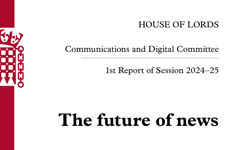
I meet Harry Owen, chief operating officer of City AM, in the members’ area at M Threadneedle, a chic and cavernous eatery in the heart of the Square Mile. The restaurant is just one of the partners in the new City AM Club, offering cardholders access to exclusive events as well as discounts on food and drink and a range of other products and services.
It is all part of the drive for media brands to diversify in ways that fit with their audience. As a free daily business newspaper, City AM provides targeted news and lifestyle features to a very specific audience, mainly in their 30s and 40s, with a 60/40 male/female split, working and living in the City of London and Canary Wharf with an average salary of around £70k.
Owen was part of the original team which set up City AM in 2005 but left for four years to work in the hospitality industry before returning to the newspaper with a fresh perspective on how to drive revenues.
Owen says: “It’s a virtual club. Geographically, our audience are in the Square Mile and Canary Wharf. We have a very tightly controlled audience when it comes to where they eat, drink and also live.”
“The relationship had begun in print and then crossed to digital and magazines and we were creating quite traditional media products. I helped start City AM in 2005, but I left for four years. I went and did hospitality, so it was much easier for me to establish relationships with food and drink in the Square Mile because I knew them, whether it’s this restaurant or any of the 50 plus partners we have.”
Advertisers now realise there is a value to curated products with audiences that are defined and relevant with high-dwell time.
The offer
City AM Club partners include multiple bars and restaurants, financial and property investment companies, sporting events, car dealers, clothing brands and Virgin gyms. Those who stump up the £240 for a membership card will also receive a £100 voucher for Gaucho and access to a range of events such as a vertical wine-tasting with Mark Hix, a women-only event on the power of good conversation and a walking tour of the Square Mile with Leica cameras.
Owen says the aggregated value of all the benefits is around “£9,000 if you took them all – no one would”. He believes the changing nature of the City since the early days of City AM, with more women working there and a greater choice of dining and drinking establishments, has made the club possible. “Ten years ago, this wouldn’t have been possible, there wasn’t the infrastructure,” he says.
One of the reasons for setting up the club was that City AM’s advertising clients were asking to meet the newspaper’s audience face to face. This does not mean that those attending City AM Club events will be subjected to a hard sell. “I think our partners are sensible; they know that our readers are sophisticated consumers and can see a sale coming a mile away,” says Owen.
The club is currently in its infancy. When we meet in June it is only a week old and has around 300 members. “Our ambition is to have 5,000 members if not more. I can see a level of scale where it could be much bigger if corporates buy this as an employee benefit,” says Owen.
He adds: “We make money on the card sale, but we don’t make money on what happens to that afterwards. There’s no deal with our partners to take a percentage of spend. We are simply an intermediary between member and partner. That makes a lot of sense because we are a media company that talks to them. We curate financial information every day. Now we are curating lifestyle information.”
Owen sees the club as a natural evolution from what City AM already does. “City AM is still owned by the same people as when I joined in 2005. We are all entrepreneurs really, and it’s worth remembering we haven’t just invented this lifestyle idea today; the back half of our newspaper has been lifestyle for fourteen years and we have a well-established magazine, a very good lifestyle desk and a great lifestyle editor Steve Dinneen who’s been with us over a decade. He and I worked very closely on what partners we wanted to reach out to, to create the club.”
“Me working in hospitality helped. I understand what restaurants are trying to do and it’s much easier for me to have conversations about interesting events having lived that life for a bit. What we don’t want to do is start putting on whisky tastings, because this audience is quite well serviced with events. As part of the onboarding process, we ask our members to explain their interests to us, so we start targeting them with specific events aimed at them.”
It comes back to this idea of not trying to be all things to all people.
Revenue model
It has been a difficult time for some free print publications, with titles such as ShortList and the NME forced to close, but Owen believes City AM’s highly targeted proposition puts it in a unique position. “We are quite special in terms of where our clients sit. You could quite easily pick up City AM today and see five or six advertisers that would never advertise in mainstream newspapers because it’s B2B advertising or even B2C investment advertising. We’ve also traversed some great relationships with the agencies and with client directors. We’re more or less the same group of people that was here thirteen years ago, so we’ve got excellent relationships.”
He admits, however, that in order to thrive in a tricky media environment, the City AM team has to “work really hard”. In 2005, print advertising was 100% of revenue; now it is around 60%, but the title has seen a 10% growth in print revenue over the last year.
“I’m pretty buoyant about it. I feel that trusted print media has seen a resurgence. I think people still want products that are edited for them. There has been this shift; advertisers now realise there is a value to curated products with audiences that are defined and relevant with high-dwell time.”
“It comes back to this idea of not trying to be all things to all people. We have a very clear set of ideas about what we’re trying to do with our products. We know this audience, because we’re living the same lives as them. We have an office in Fenchurch Street. We go to the same restaurants, we eat and drink in the same places, we shop in the same shops.”
Continuing in this targeted mould, the media brand is also extending its events business. The City AM Awards are now in their tenth year and the company is starting to put on monthly events for between 100 and 200 people, focusing on personal finance, including investment seminars and a crypto-blockchain event. City AM was also the official partner of the Derby this year, producing a 24-page paper which punters picked up on the way in.
The more global the FT has become, the more it left this space for us to become London’s business financial daily.
City AM’s USPs
Owen explains that City AM’s founding philosophy is still at the heart of the way it is run today. “Our strap is ‘Business with Personality’ and that’s so key to our DNA. When we started business planning the company in 2004, we said to ourselves, we’re never going to put in a logo of a company. We remembered reading the FT and we’d see a big Goldman Sachs logo or a Merrill Lynch logo. We said we’re going to put people in, because businesses are run by people. So, we only ever have headshots, not logos.”
Having said that, Owen does not see the FT as a direct rival to City AM. “We don’t think about the FT, it’s just such a different product. I feel much more strongly that we compete with Twitter than the FT. We print so late; that’s always been our USP, we go to bed at midnight, our journalists work the latest of any journalists at any newspaper. When Lehmans went down, we were the only paper in the UK that had that on the front page, because it happened overnight in America.”
He adds: “The more global the FT has become, the more it left this space for us to become London’s business financial daily. Just by print, we’re significantly bigger than the FT in the UK. We move 85,000 copies a day.”
When City AM launched in 2005, it was with an “end of journey” distribution strategy; now that has changed to a “start of journey” strategy. “You can pick us up at Reading or Tunbridge Wells. We’ve got very good at distribution,” says Owen.
Another new source of revenue for the brand is its open CMS platform, City Talk. Owen explains: “We felt strongly that if we wanted to hear about equities from a fund manager, that the fund manager should be able to provide that content directly to our audience without the filter, because these guys know more about their subject area than our journalists. If you become a City Talk client, we onboard you and give you access to our CMS and you have someone who holds your hand. It doesn’t appeal to every client; you have to be a client with content. It tends to appeal to fund managers, brokers and specialists in their field. Rather than buying Google Search, this is a ready-made audience.”
What else does the future hold for this media brand with its feet firmly planted in the Square Mile? If Owen had his way, it would be a further marriage between his twin interests of media and hospitality. “Frankly, if I could, I’d buy a restaurant called City AM,” he says, only half joking.
When Lehmans went down, we were the only paper in the UK that had that on the front page.
This article was first published in InPublishing magazine. If you would like to be added to the free mailing list, please register here.










